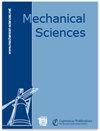Parameter optimization of a pure electric sweeper dust port by a backpropagation neural network combined with a whale algorithm
IF 1.5
4区 工程技术
Q4 ENGINEERING, MECHANICAL
引用次数: 0
Abstract
Abstract. Optimizing the structure of the suction port is the key to effectively improving the performance of the sweeping vehicle. The CFD (computational fluid dynamics) method and gas–solid two-phase flow model are used to analyse the influence rule of the structural parameters and the height above ground on the cleaning effect, which is verified by real vehicle tests. The data set was established by an orthogonal test method, and a BP (backpropagation) neural network was used to fit the structural parameters and evaluation indexes. The fitting errors were all within 5 %, indicating that the fitting results of this method were good. According to the fitting relation of the BP neural network output, the whale algorithm should be further used to solve the optimal structural parameters. The results show that the optimal parameter combination is β=63∘, d=168 mm and h=12 mm. The energy consumption of the optimized model is reduced, and the internal airflow loss is reduced. The particle residence time becomes shorter, and the particle can flow out from the outlet faster, thus improving the dust absorption effect. The research can provide a theoretical reference for performance optimization and parameter matching of sweepers.基于反向传播神经网络和鲸鱼算法的纯电动清扫器除尘口参数优化
摘要优化吸风口结构是有效提高清扫车性能的关键。采用CFD(计算流体力学)方法和气固两相流模型分析了结构参数和地面高度对清洗效果的影响规律,并通过实车试验验证了这一点。采用正交试验方法建立数据集,并采用aBP神经网络对结构参数和评价指标进行拟合。拟合误差均在5以内 %,表明该方法拟合效果良好。根据BP神经网络输出的拟合关系,应进一步使用whale算法求解最优结构参数。结果表明,最佳参数组合为β=63∘,d=168 mm和h=12 优化模型的能耗降低,内部气流损失减少。颗粒的停留时间变短,颗粒可以更快地从出口流出,从而改善灰尘的吸收效果。该研究可为清扫车的性能优化和参数匹配提供理论参考。
本文章由计算机程序翻译,如有差异,请以英文原文为准。
求助全文
约1分钟内获得全文
求助全文
来源期刊

Mechanical Sciences
ENGINEERING, MECHANICAL-
CiteScore
2.20
自引率
7.10%
发文量
74
审稿时长
29 weeks
期刊介绍:
The journal Mechanical Sciences (MS) is an international forum for the dissemination of original contributions in the field of theoretical and applied mechanics. Its main ambition is to provide a platform for young researchers to build up a portfolio of high-quality peer-reviewed journal articles. To this end we employ an open-access publication model with moderate page charges, aiming for fast publication and great citation opportunities. A large board of reputable editors makes this possible. The journal will also publish special issues dealing with the current state of the art and future research directions in mechanical sciences. While in-depth research articles are preferred, review articles and short communications will also be considered. We intend and believe to provide a means of publication which complements established journals in the field.
 求助内容:
求助内容: 应助结果提醒方式:
应助结果提醒方式:


